Relationship Between Ruminant Anatomy, Physiology & GHG Emission
VerifiedAdded on 2023/06/07
|9
|2397
|245
Report
AI Summary
This report explores the intricate relationship between the anatomy and physiology of ruminants and the emission of greenhouse gases, particularly methane. Ruminants, with their unique four-compartment stomach system (rumen, reticulum, omasum, and abomasum), harbor diverse microorganisms in the rumen that facilitate the fermentation of complex carbohydrates into volatile fatty acids and gases. The fermentation process, while enabling efficient nutrient utilization, also results in the production of methane, a potent greenhouse gas, which is expelled through belching. The report details the passage of food through the ruminant digestive system, emphasizing the importance of rumination, saliva production, and rumen pH in maintaining optimal microbial activity. It further highlights the contribution of ruminant livestock to global greenhouse gas emissions, with a focus on methane production in the rumen. The report concludes by discussing strategies to minimize methane emissions through diet and nutrition management, such as feeding ruminants with low-fiber forage and soluble carbohydrates. This document is available on Desklib, a platform offering a wide range of study resources for students.
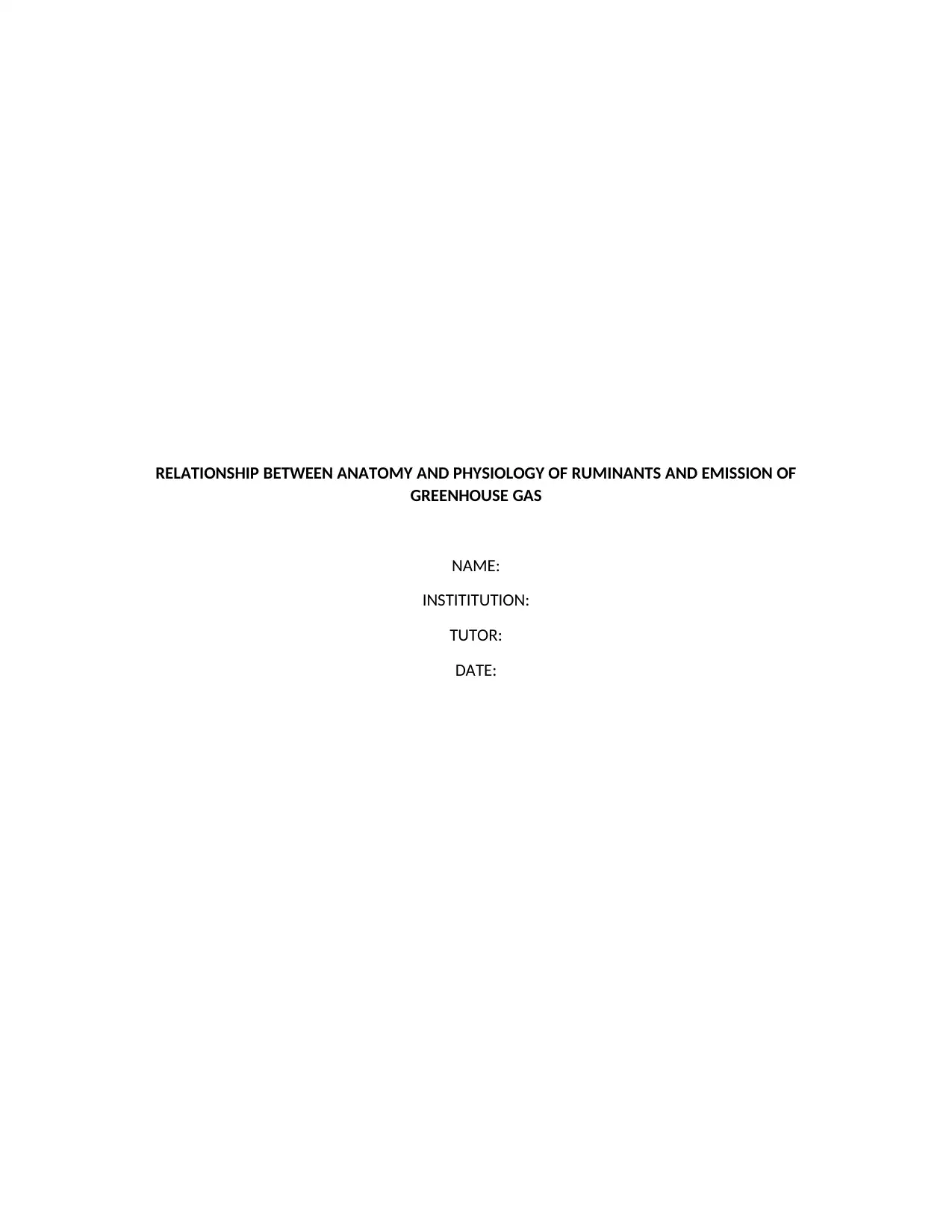
RELATIONSHIP BETWEEN ANATOMY AND PHYSIOLOGY OF RUMINANTS AND EMISSION OF
GREENHOUSE GAS
NAME:
INSTITITUTION:
TUTOR:
DATE:
GREENHOUSE GAS
NAME:
INSTITITUTION:
TUTOR:
DATE:
Paraphrase This Document
Need a fresh take? Get an instant paraphrase of this document with our AI Paraphraser
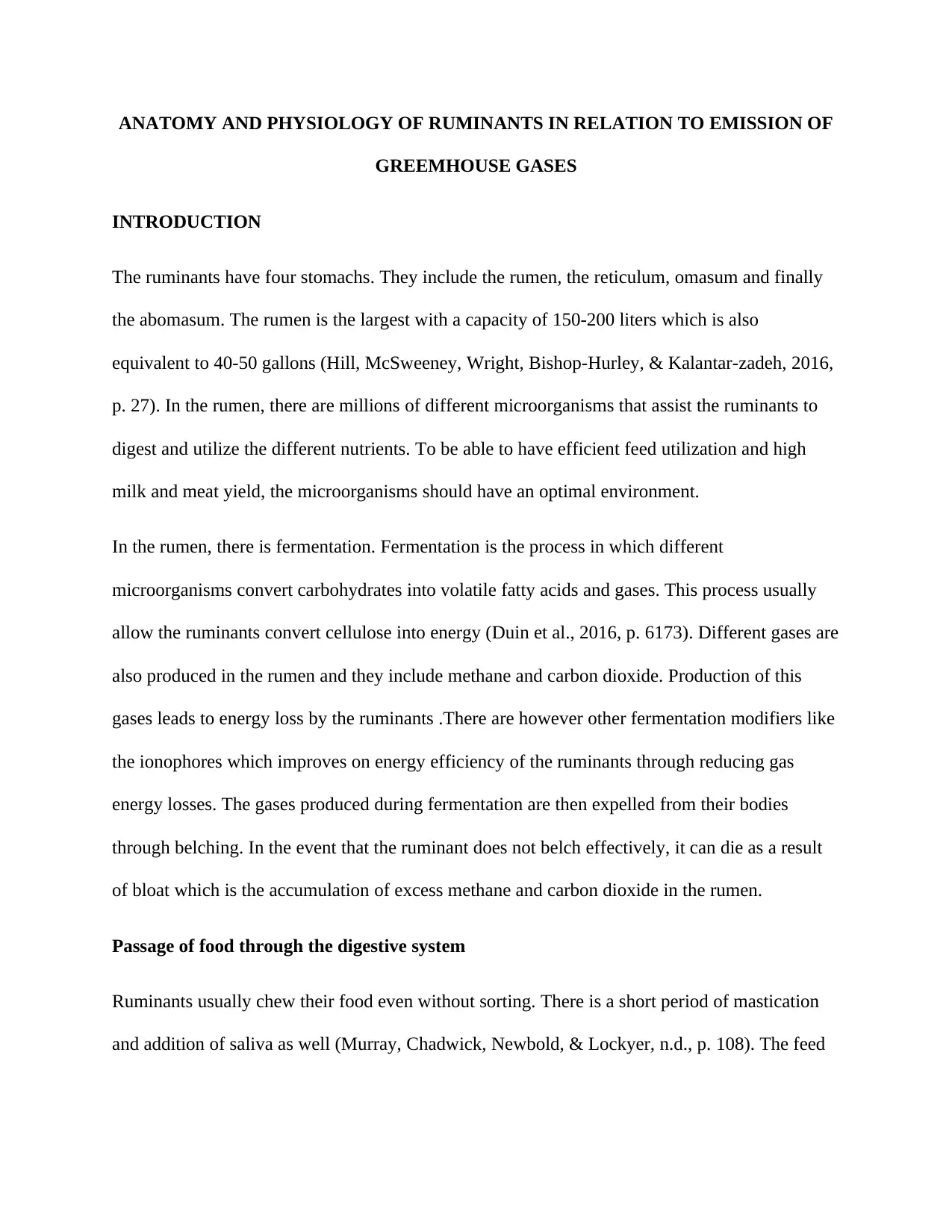
ANATOMY AND PHYSIOLOGY OF RUMINANTS IN RELATION TO EMISSION OF
GREEMHOUSE GASES
INTRODUCTION
The ruminants have four stomachs. They include the rumen, the reticulum, omasum and finally
the abomasum. The rumen is the largest with a capacity of 150-200 liters which is also
equivalent to 40-50 gallons (Hill, McSweeney, Wright, Bishop-Hurley, & Kalantar-zadeh, 2016,
p. 27). In the rumen, there are millions of different microorganisms that assist the ruminants to
digest and utilize the different nutrients. To be able to have efficient feed utilization and high
milk and meat yield, the microorganisms should have an optimal environment.
In the rumen, there is fermentation. Fermentation is the process in which different
microorganisms convert carbohydrates into volatile fatty acids and gases. This process usually
allow the ruminants convert cellulose into energy (Duin et al., 2016, p. 6173). Different gases are
also produced in the rumen and they include methane and carbon dioxide. Production of this
gases leads to energy loss by the ruminants .There are however other fermentation modifiers like
the ionophores which improves on energy efficiency of the ruminants through reducing gas
energy losses. The gases produced during fermentation are then expelled from their bodies
through belching. In the event that the ruminant does not belch effectively, it can die as a result
of bloat which is the accumulation of excess methane and carbon dioxide in the rumen.
Passage of food through the digestive system
Ruminants usually chew their food even without sorting. There is a short period of mastication
and addition of saliva as well (Murray, Chadwick, Newbold, & Lockyer, n.d., p. 108). The feed
GREEMHOUSE GASES
INTRODUCTION
The ruminants have four stomachs. They include the rumen, the reticulum, omasum and finally
the abomasum. The rumen is the largest with a capacity of 150-200 liters which is also
equivalent to 40-50 gallons (Hill, McSweeney, Wright, Bishop-Hurley, & Kalantar-zadeh, 2016,
p. 27). In the rumen, there are millions of different microorganisms that assist the ruminants to
digest and utilize the different nutrients. To be able to have efficient feed utilization and high
milk and meat yield, the microorganisms should have an optimal environment.
In the rumen, there is fermentation. Fermentation is the process in which different
microorganisms convert carbohydrates into volatile fatty acids and gases. This process usually
allow the ruminants convert cellulose into energy (Duin et al., 2016, p. 6173). Different gases are
also produced in the rumen and they include methane and carbon dioxide. Production of this
gases leads to energy loss by the ruminants .There are however other fermentation modifiers like
the ionophores which improves on energy efficiency of the ruminants through reducing gas
energy losses. The gases produced during fermentation are then expelled from their bodies
through belching. In the event that the ruminant does not belch effectively, it can die as a result
of bloat which is the accumulation of excess methane and carbon dioxide in the rumen.
Passage of food through the digestive system
Ruminants usually chew their food even without sorting. There is a short period of mastication
and addition of saliva as well (Murray, Chadwick, Newbold, & Lockyer, n.d., p. 108). The feed
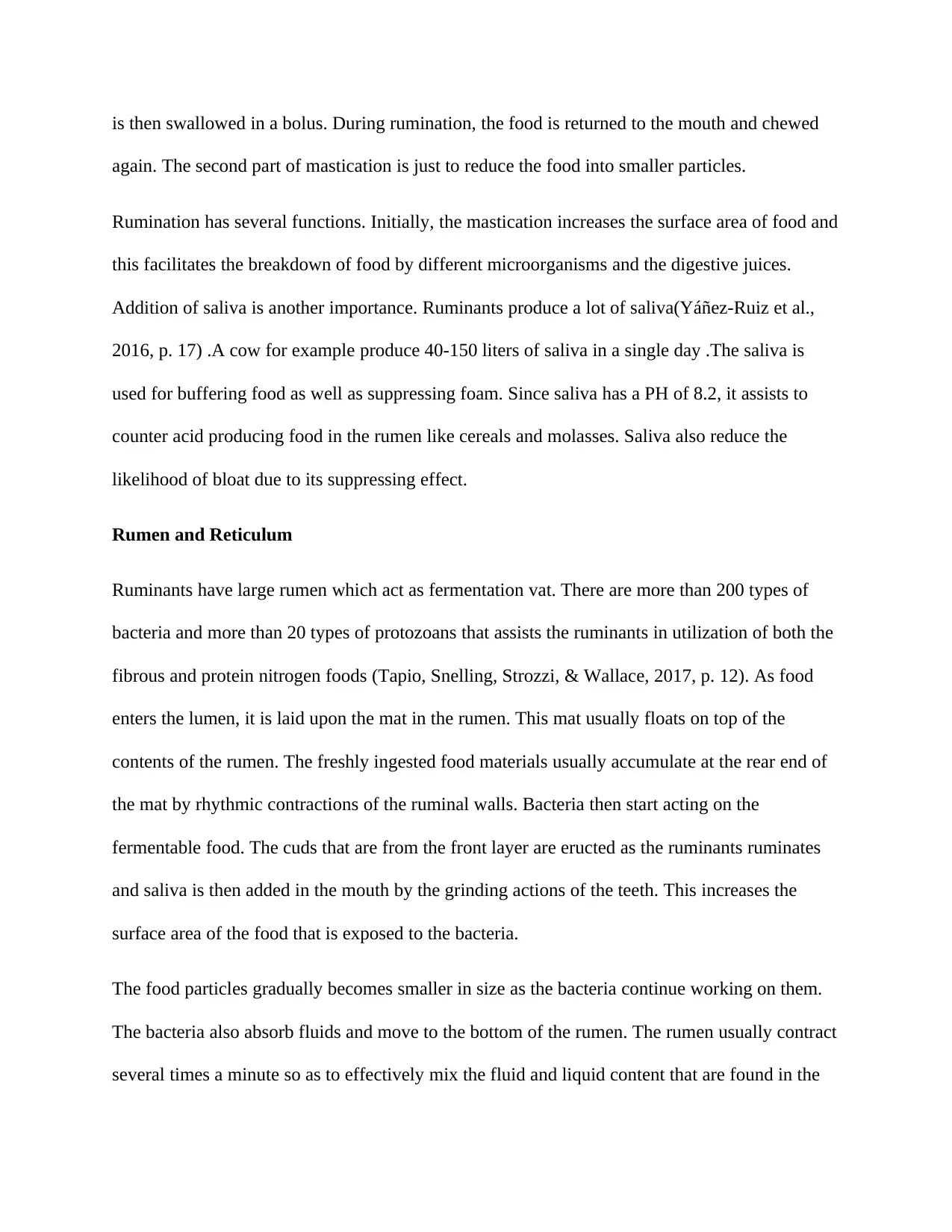
is then swallowed in a bolus. During rumination, the food is returned to the mouth and chewed
again. The second part of mastication is just to reduce the food into smaller particles.
Rumination has several functions. Initially, the mastication increases the surface area of food and
this facilitates the breakdown of food by different microorganisms and the digestive juices.
Addition of saliva is another importance. Ruminants produce a lot of saliva(Yáñez-Ruiz et al.,
2016, p. 17) .A cow for example produce 40-150 liters of saliva in a single day .The saliva is
used for buffering food as well as suppressing foam. Since saliva has a PH of 8.2, it assists to
counter acid producing food in the rumen like cereals and molasses. Saliva also reduce the
likelihood of bloat due to its suppressing effect.
Rumen and Reticulum
Ruminants have large rumen which act as fermentation vat. There are more than 200 types of
bacteria and more than 20 types of protozoans that assists the ruminants in utilization of both the
fibrous and protein nitrogen foods (Tapio, Snelling, Strozzi, & Wallace, 2017, p. 12). As food
enters the lumen, it is laid upon the mat in the rumen. This mat usually floats on top of the
contents of the rumen. The freshly ingested food materials usually accumulate at the rear end of
the mat by rhythmic contractions of the ruminal walls. Bacteria then start acting on the
fermentable food. The cuds that are from the front layer are eructed as the ruminants ruminates
and saliva is then added in the mouth by the grinding actions of the teeth. This increases the
surface area of the food that is exposed to the bacteria.
The food particles gradually becomes smaller in size as the bacteria continue working on them.
The bacteria also absorb fluids and move to the bottom of the rumen. The rumen usually contract
several times a minute so as to effectively mix the fluid and liquid content that are found in the
again. The second part of mastication is just to reduce the food into smaller particles.
Rumination has several functions. Initially, the mastication increases the surface area of food and
this facilitates the breakdown of food by different microorganisms and the digestive juices.
Addition of saliva is another importance. Ruminants produce a lot of saliva(Yáñez-Ruiz et al.,
2016, p. 17) .A cow for example produce 40-150 liters of saliva in a single day .The saliva is
used for buffering food as well as suppressing foam. Since saliva has a PH of 8.2, it assists to
counter acid producing food in the rumen like cereals and molasses. Saliva also reduce the
likelihood of bloat due to its suppressing effect.
Rumen and Reticulum
Ruminants have large rumen which act as fermentation vat. There are more than 200 types of
bacteria and more than 20 types of protozoans that assists the ruminants in utilization of both the
fibrous and protein nitrogen foods (Tapio, Snelling, Strozzi, & Wallace, 2017, p. 12). As food
enters the lumen, it is laid upon the mat in the rumen. This mat usually floats on top of the
contents of the rumen. The freshly ingested food materials usually accumulate at the rear end of
the mat by rhythmic contractions of the ruminal walls. Bacteria then start acting on the
fermentable food. The cuds that are from the front layer are eructed as the ruminants ruminates
and saliva is then added in the mouth by the grinding actions of the teeth. This increases the
surface area of the food that is exposed to the bacteria.
The food particles gradually becomes smaller in size as the bacteria continue working on them.
The bacteria also absorb fluids and move to the bottom of the rumen. The rumen usually contract
several times a minute so as to effectively mix the fluid and liquid content that are found in the
⊘ This is a preview!⊘
Do you want full access?
Subscribe today to unlock all pages.

Trusted by 1+ million students worldwide
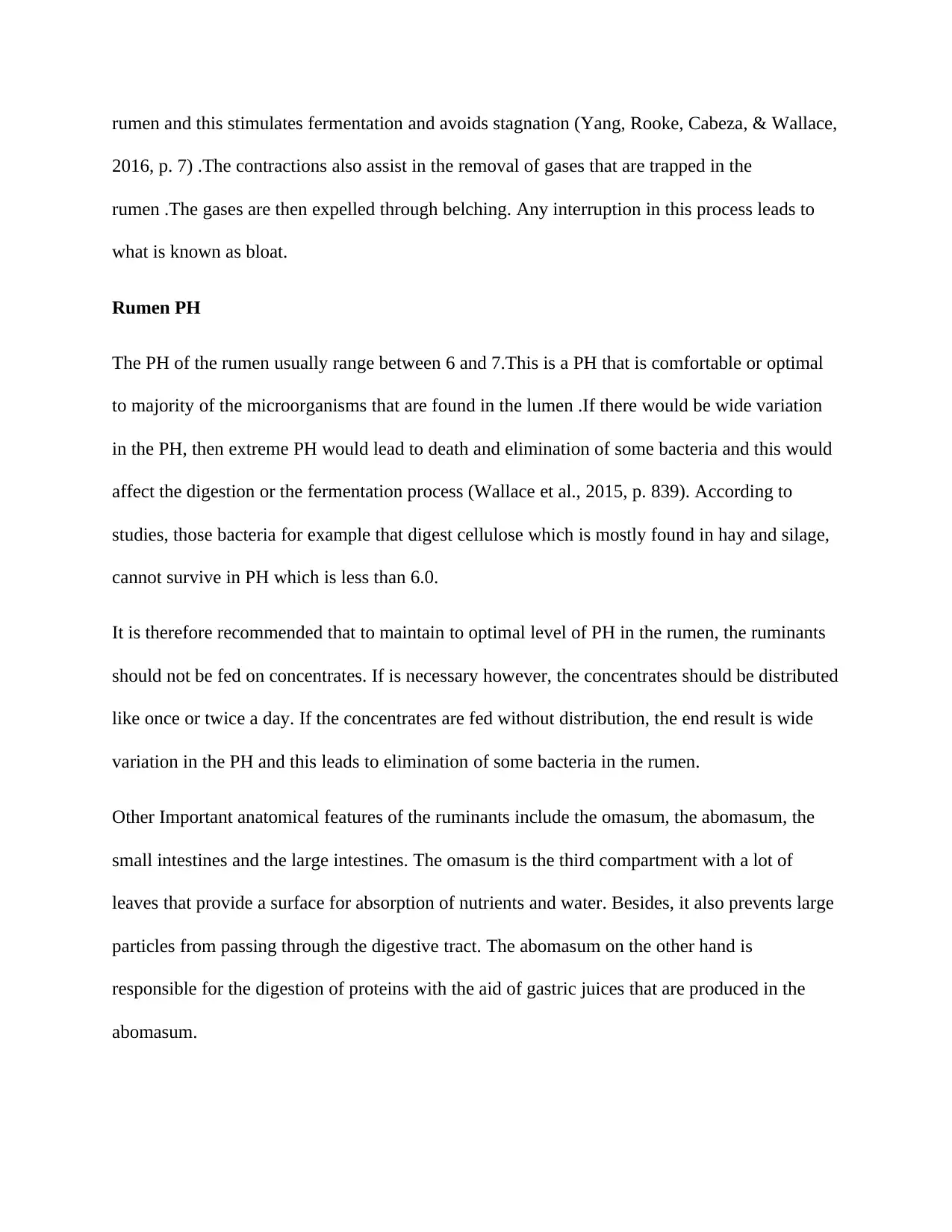
rumen and this stimulates fermentation and avoids stagnation (Yang, Rooke, Cabeza, & Wallace,
2016, p. 7) .The contractions also assist in the removal of gases that are trapped in the
rumen .The gases are then expelled through belching. Any interruption in this process leads to
what is known as bloat.
Rumen PH
The PH of the rumen usually range between 6 and 7.This is a PH that is comfortable or optimal
to majority of the microorganisms that are found in the lumen .If there would be wide variation
in the PH, then extreme PH would lead to death and elimination of some bacteria and this would
affect the digestion or the fermentation process (Wallace et al., 2015, p. 839). According to
studies, those bacteria for example that digest cellulose which is mostly found in hay and silage,
cannot survive in PH which is less than 6.0.
It is therefore recommended that to maintain to optimal level of PH in the rumen, the ruminants
should not be fed on concentrates. If is necessary however, the concentrates should be distributed
like once or twice a day. If the concentrates are fed without distribution, the end result is wide
variation in the PH and this leads to elimination of some bacteria in the rumen.
Other Important anatomical features of the ruminants include the omasum, the abomasum, the
small intestines and the large intestines. The omasum is the third compartment with a lot of
leaves that provide a surface for absorption of nutrients and water. Besides, it also prevents large
particles from passing through the digestive tract. The abomasum on the other hand is
responsible for the digestion of proteins with the aid of gastric juices that are produced in the
abomasum.
2016, p. 7) .The contractions also assist in the removal of gases that are trapped in the
rumen .The gases are then expelled through belching. Any interruption in this process leads to
what is known as bloat.
Rumen PH
The PH of the rumen usually range between 6 and 7.This is a PH that is comfortable or optimal
to majority of the microorganisms that are found in the lumen .If there would be wide variation
in the PH, then extreme PH would lead to death and elimination of some bacteria and this would
affect the digestion or the fermentation process (Wallace et al., 2015, p. 839). According to
studies, those bacteria for example that digest cellulose which is mostly found in hay and silage,
cannot survive in PH which is less than 6.0.
It is therefore recommended that to maintain to optimal level of PH in the rumen, the ruminants
should not be fed on concentrates. If is necessary however, the concentrates should be distributed
like once or twice a day. If the concentrates are fed without distribution, the end result is wide
variation in the PH and this leads to elimination of some bacteria in the rumen.
Other Important anatomical features of the ruminants include the omasum, the abomasum, the
small intestines and the large intestines. The omasum is the third compartment with a lot of
leaves that provide a surface for absorption of nutrients and water. Besides, it also prevents large
particles from passing through the digestive tract. The abomasum on the other hand is
responsible for the digestion of proteins with the aid of gastric juices that are produced in the
abomasum.
Paraphrase This Document
Need a fresh take? Get an instant paraphrase of this document with our AI Paraphraser
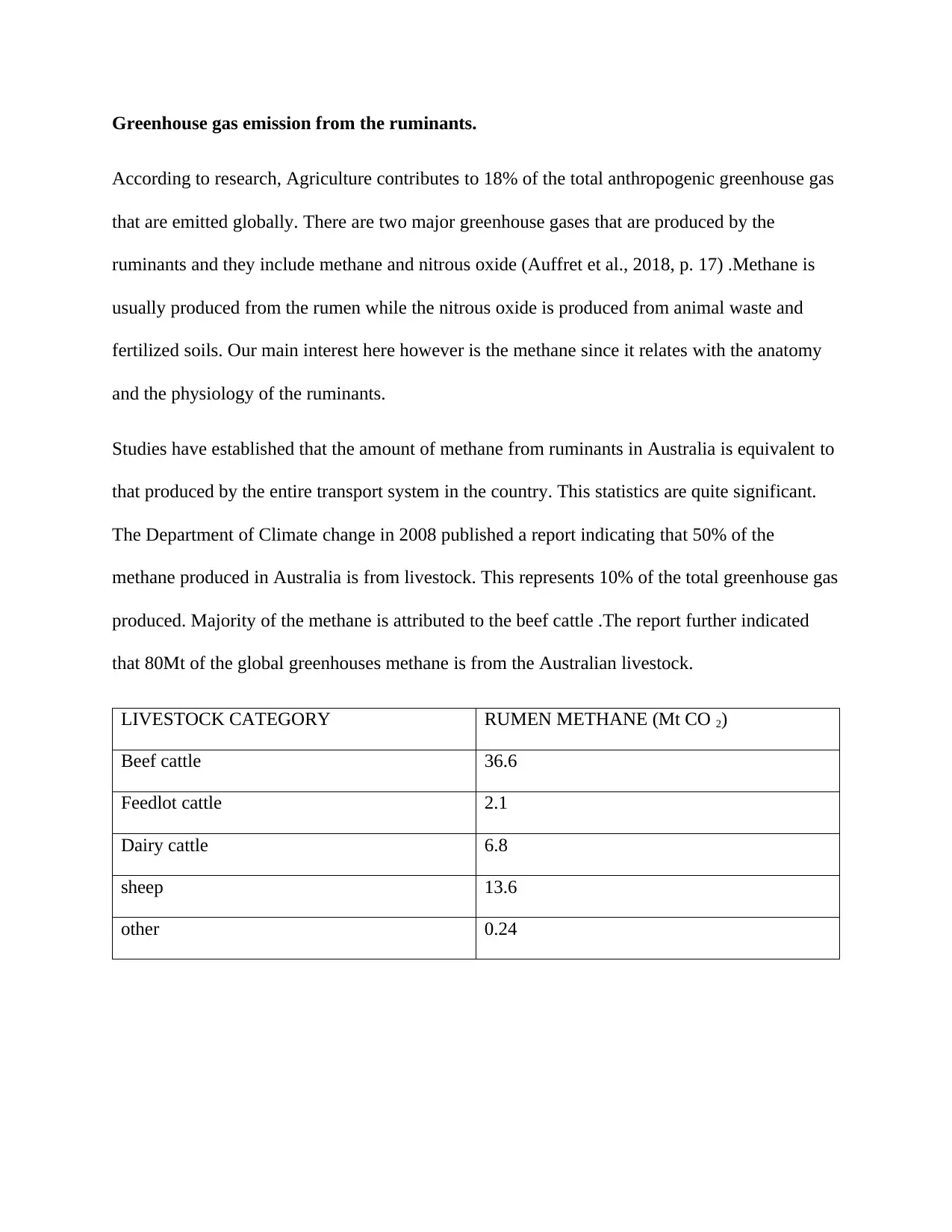
Greenhouse gas emission from the ruminants.
According to research, Agriculture contributes to 18% of the total anthropogenic greenhouse gas
that are emitted globally. There are two major greenhouse gases that are produced by the
ruminants and they include methane and nitrous oxide (Auffret et al., 2018, p. 17) .Methane is
usually produced from the rumen while the nitrous oxide is produced from animal waste and
fertilized soils. Our main interest here however is the methane since it relates with the anatomy
and the physiology of the ruminants.
Studies have established that the amount of methane from ruminants in Australia is equivalent to
that produced by the entire transport system in the country. This statistics are quite significant.
The Department of Climate change in 2008 published a report indicating that 50% of the
methane produced in Australia is from livestock. This represents 10% of the total greenhouse gas
produced. Majority of the methane is attributed to the beef cattle .The report further indicated
that 80Mt of the global greenhouses methane is from the Australian livestock.
LIVESTOCK CATEGORY RUMEN METHANE (Mt CO 2)
Beef cattle 36.6
Feedlot cattle 2.1
Dairy cattle 6.8
sheep 13.6
other 0.24
According to research, Agriculture contributes to 18% of the total anthropogenic greenhouse gas
that are emitted globally. There are two major greenhouse gases that are produced by the
ruminants and they include methane and nitrous oxide (Auffret et al., 2018, p. 17) .Methane is
usually produced from the rumen while the nitrous oxide is produced from animal waste and
fertilized soils. Our main interest here however is the methane since it relates with the anatomy
and the physiology of the ruminants.
Studies have established that the amount of methane from ruminants in Australia is equivalent to
that produced by the entire transport system in the country. This statistics are quite significant.
The Department of Climate change in 2008 published a report indicating that 50% of the
methane produced in Australia is from livestock. This represents 10% of the total greenhouse gas
produced. Majority of the methane is attributed to the beef cattle .The report further indicated
that 80Mt of the global greenhouses methane is from the Australian livestock.
LIVESTOCK CATEGORY RUMEN METHANE (Mt CO 2)
Beef cattle 36.6
Feedlot cattle 2.1
Dairy cattle 6.8
sheep 13.6
other 0.24
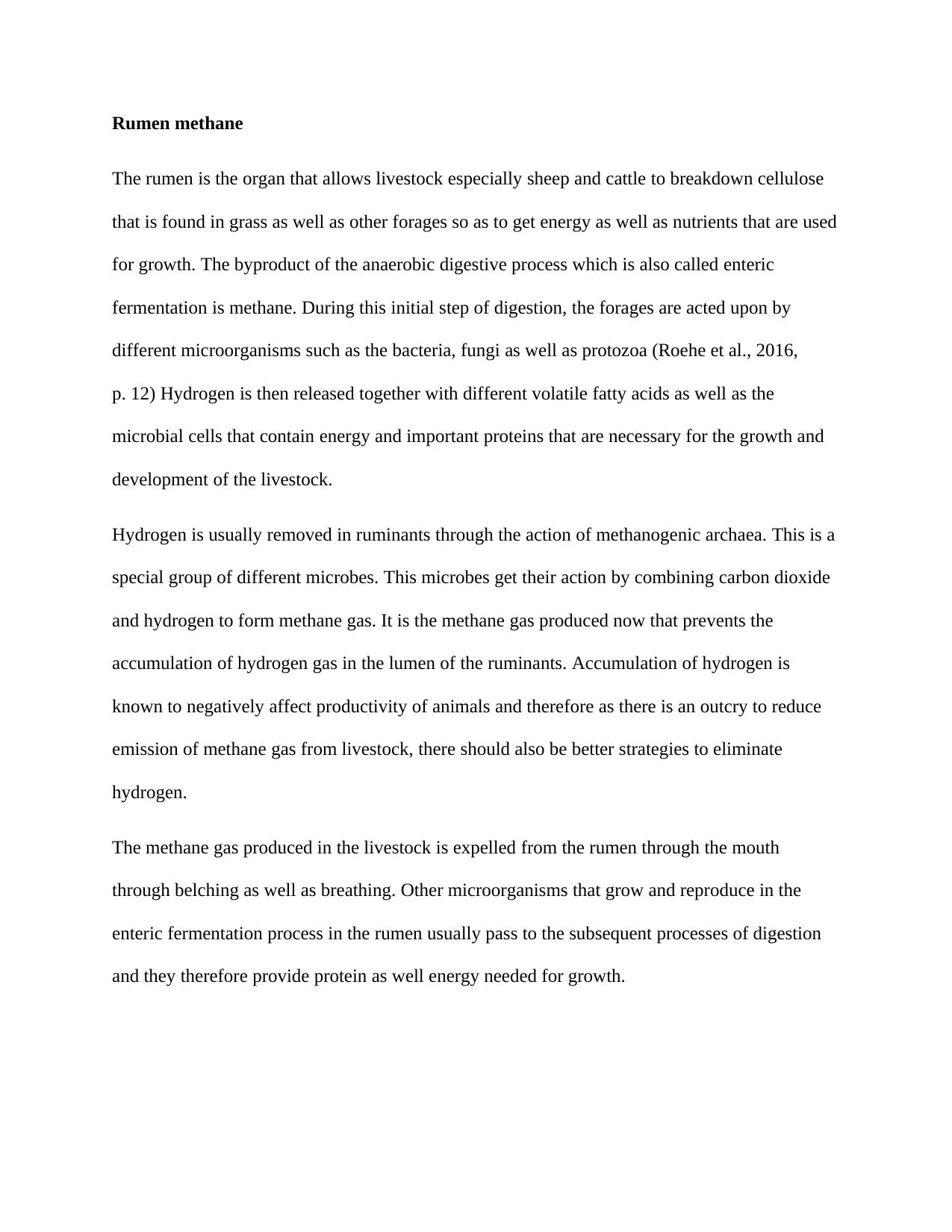
Rumen methane
The rumen is the organ that allows livestock especially sheep and cattle to breakdown cellulose
that is found in grass as well as other forages so as to get energy as well as nutrients that are used
for growth. The byproduct of the anaerobic digestive process which is also called enteric
fermentation is methane. During this initial step of digestion, the forages are acted upon by
different microorganisms such as the bacteria, fungi as well as protozoa (Roehe et al., 2016,
p. 12) Hydrogen is then released together with different volatile fatty acids as well as the
microbial cells that contain energy and important proteins that are necessary for the growth and
development of the livestock.
Hydrogen is usually removed in ruminants through the action of methanogenic archaea. This is a
special group of different microbes. This microbes get their action by combining carbon dioxide
and hydrogen to form methane gas. It is the methane gas produced now that prevents the
accumulation of hydrogen gas in the lumen of the ruminants. Accumulation of hydrogen is
known to negatively affect productivity of animals and therefore as there is an outcry to reduce
emission of methane gas from livestock, there should also be better strategies to eliminate
hydrogen.
The methane gas produced in the livestock is expelled from the rumen through the mouth
through belching as well as breathing. Other microorganisms that grow and reproduce in the
enteric fermentation process in the rumen usually pass to the subsequent processes of digestion
and they therefore provide protein as well energy needed for growth.
The rumen is the organ that allows livestock especially sheep and cattle to breakdown cellulose
that is found in grass as well as other forages so as to get energy as well as nutrients that are used
for growth. The byproduct of the anaerobic digestive process which is also called enteric
fermentation is methane. During this initial step of digestion, the forages are acted upon by
different microorganisms such as the bacteria, fungi as well as protozoa (Roehe et al., 2016,
p. 12) Hydrogen is then released together with different volatile fatty acids as well as the
microbial cells that contain energy and important proteins that are necessary for the growth and
development of the livestock.
Hydrogen is usually removed in ruminants through the action of methanogenic archaea. This is a
special group of different microbes. This microbes get their action by combining carbon dioxide
and hydrogen to form methane gas. It is the methane gas produced now that prevents the
accumulation of hydrogen gas in the lumen of the ruminants. Accumulation of hydrogen is
known to negatively affect productivity of animals and therefore as there is an outcry to reduce
emission of methane gas from livestock, there should also be better strategies to eliminate
hydrogen.
The methane gas produced in the livestock is expelled from the rumen through the mouth
through belching as well as breathing. Other microorganisms that grow and reproduce in the
enteric fermentation process in the rumen usually pass to the subsequent processes of digestion
and they therefore provide protein as well energy needed for growth.
⊘ This is a preview!⊘
Do you want full access?
Subscribe today to unlock all pages.

Trusted by 1+ million students worldwide
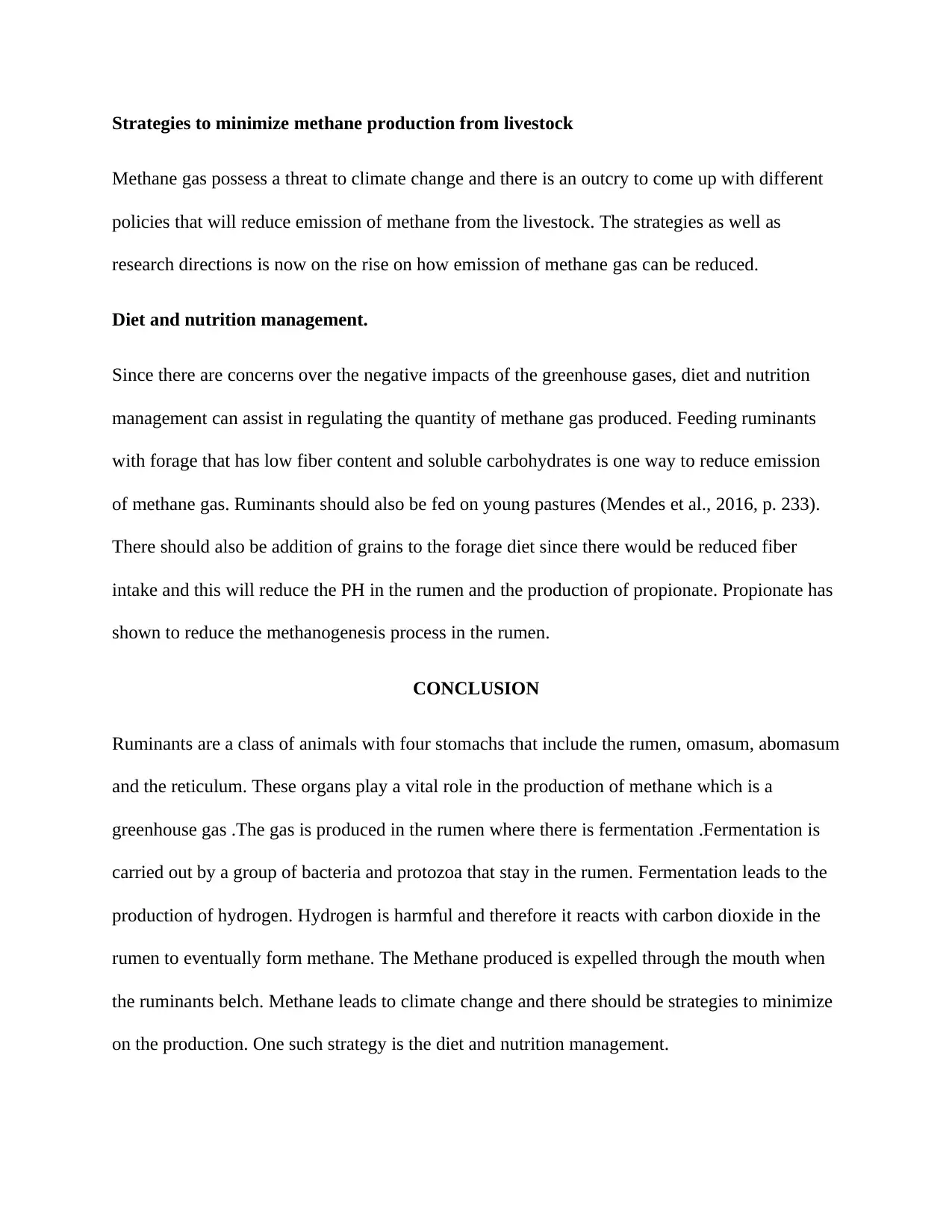
Strategies to minimize methane production from livestock
Methane gas possess a threat to climate change and there is an outcry to come up with different
policies that will reduce emission of methane from the livestock. The strategies as well as
research directions is now on the rise on how emission of methane gas can be reduced.
Diet and nutrition management.
Since there are concerns over the negative impacts of the greenhouse gases, diet and nutrition
management can assist in regulating the quantity of methane gas produced. Feeding ruminants
with forage that has low fiber content and soluble carbohydrates is one way to reduce emission
of methane gas. Ruminants should also be fed on young pastures (Mendes et al., 2016, p. 233).
There should also be addition of grains to the forage diet since there would be reduced fiber
intake and this will reduce the PH in the rumen and the production of propionate. Propionate has
shown to reduce the methanogenesis process in the rumen.
CONCLUSION
Ruminants are a class of animals with four stomachs that include the rumen, omasum, abomasum
and the reticulum. These organs play a vital role in the production of methane which is a
greenhouse gas .The gas is produced in the rumen where there is fermentation .Fermentation is
carried out by a group of bacteria and protozoa that stay in the rumen. Fermentation leads to the
production of hydrogen. Hydrogen is harmful and therefore it reacts with carbon dioxide in the
rumen to eventually form methane. The Methane produced is expelled through the mouth when
the ruminants belch. Methane leads to climate change and there should be strategies to minimize
on the production. One such strategy is the diet and nutrition management.
Methane gas possess a threat to climate change and there is an outcry to come up with different
policies that will reduce emission of methane from the livestock. The strategies as well as
research directions is now on the rise on how emission of methane gas can be reduced.
Diet and nutrition management.
Since there are concerns over the negative impacts of the greenhouse gases, diet and nutrition
management can assist in regulating the quantity of methane gas produced. Feeding ruminants
with forage that has low fiber content and soluble carbohydrates is one way to reduce emission
of methane gas. Ruminants should also be fed on young pastures (Mendes et al., 2016, p. 233).
There should also be addition of grains to the forage diet since there would be reduced fiber
intake and this will reduce the PH in the rumen and the production of propionate. Propionate has
shown to reduce the methanogenesis process in the rumen.
CONCLUSION
Ruminants are a class of animals with four stomachs that include the rumen, omasum, abomasum
and the reticulum. These organs play a vital role in the production of methane which is a
greenhouse gas .The gas is produced in the rumen where there is fermentation .Fermentation is
carried out by a group of bacteria and protozoa that stay in the rumen. Fermentation leads to the
production of hydrogen. Hydrogen is harmful and therefore it reacts with carbon dioxide in the
rumen to eventually form methane. The Methane produced is expelled through the mouth when
the ruminants belch. Methane leads to climate change and there should be strategies to minimize
on the production. One such strategy is the diet and nutrition management.
Paraphrase This Document
Need a fresh take? Get an instant paraphrase of this document with our AI Paraphraser
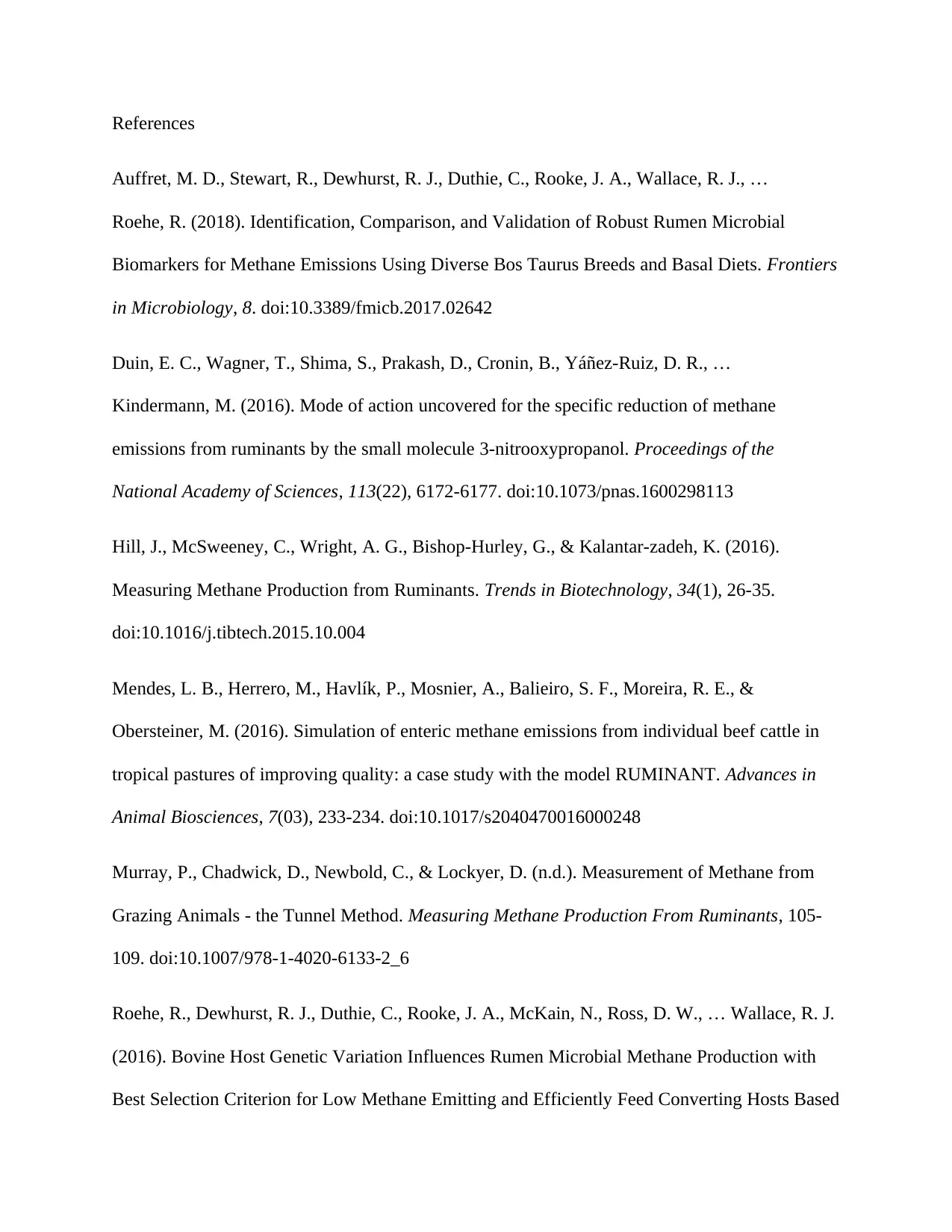
References
Auffret, M. D., Stewart, R., Dewhurst, R. J., Duthie, C., Rooke, J. A., Wallace, R. J., …
Roehe, R. (2018). Identification, Comparison, and Validation of Robust Rumen Microbial
Biomarkers for Methane Emissions Using Diverse Bos Taurus Breeds and Basal Diets. Frontiers
in Microbiology, 8. doi:10.3389/fmicb.2017.02642
Duin, E. C., Wagner, T., Shima, S., Prakash, D., Cronin, B., Yáñez-Ruiz, D. R., …
Kindermann, M. (2016). Mode of action uncovered for the specific reduction of methane
emissions from ruminants by the small molecule 3-nitrooxypropanol. Proceedings of the
National Academy of Sciences, 113(22), 6172-6177. doi:10.1073/pnas.1600298113
Hill, J., McSweeney, C., Wright, A. G., Bishop-Hurley, G., & Kalantar-zadeh, K. (2016).
Measuring Methane Production from Ruminants. Trends in Biotechnology, 34(1), 26-35.
doi:10.1016/j.tibtech.2015.10.004
Mendes, L. B., Herrero, M., Havlík, P., Mosnier, A., Balieiro, S. F., Moreira, R. E., &
Obersteiner, M. (2016). Simulation of enteric methane emissions from individual beef cattle in
tropical pastures of improving quality: a case study with the model RUMINANT. Advances in
Animal Biosciences, 7(03), 233-234. doi:10.1017/s2040470016000248
Murray, P., Chadwick, D., Newbold, C., & Lockyer, D. (n.d.). Measurement of Methane from
Grazing Animals - the Tunnel Method. Measuring Methane Production From Ruminants, 105-
109. doi:10.1007/978-1-4020-6133-2_6
Roehe, R., Dewhurst, R. J., Duthie, C., Rooke, J. A., McKain, N., Ross, D. W., … Wallace, R. J.
(2016). Bovine Host Genetic Variation Influences Rumen Microbial Methane Production with
Best Selection Criterion for Low Methane Emitting and Efficiently Feed Converting Hosts Based
Auffret, M. D., Stewart, R., Dewhurst, R. J., Duthie, C., Rooke, J. A., Wallace, R. J., …
Roehe, R. (2018). Identification, Comparison, and Validation of Robust Rumen Microbial
Biomarkers for Methane Emissions Using Diverse Bos Taurus Breeds and Basal Diets. Frontiers
in Microbiology, 8. doi:10.3389/fmicb.2017.02642
Duin, E. C., Wagner, T., Shima, S., Prakash, D., Cronin, B., Yáñez-Ruiz, D. R., …
Kindermann, M. (2016). Mode of action uncovered for the specific reduction of methane
emissions from ruminants by the small molecule 3-nitrooxypropanol. Proceedings of the
National Academy of Sciences, 113(22), 6172-6177. doi:10.1073/pnas.1600298113
Hill, J., McSweeney, C., Wright, A. G., Bishop-Hurley, G., & Kalantar-zadeh, K. (2016).
Measuring Methane Production from Ruminants. Trends in Biotechnology, 34(1), 26-35.
doi:10.1016/j.tibtech.2015.10.004
Mendes, L. B., Herrero, M., Havlík, P., Mosnier, A., Balieiro, S. F., Moreira, R. E., &
Obersteiner, M. (2016). Simulation of enteric methane emissions from individual beef cattle in
tropical pastures of improving quality: a case study with the model RUMINANT. Advances in
Animal Biosciences, 7(03), 233-234. doi:10.1017/s2040470016000248
Murray, P., Chadwick, D., Newbold, C., & Lockyer, D. (n.d.). Measurement of Methane from
Grazing Animals - the Tunnel Method. Measuring Methane Production From Ruminants, 105-
109. doi:10.1007/978-1-4020-6133-2_6
Roehe, R., Dewhurst, R. J., Duthie, C., Rooke, J. A., McKain, N., Ross, D. W., … Wallace, R. J.
(2016). Bovine Host Genetic Variation Influences Rumen Microbial Methane Production with
Best Selection Criterion for Low Methane Emitting and Efficiently Feed Converting Hosts Based
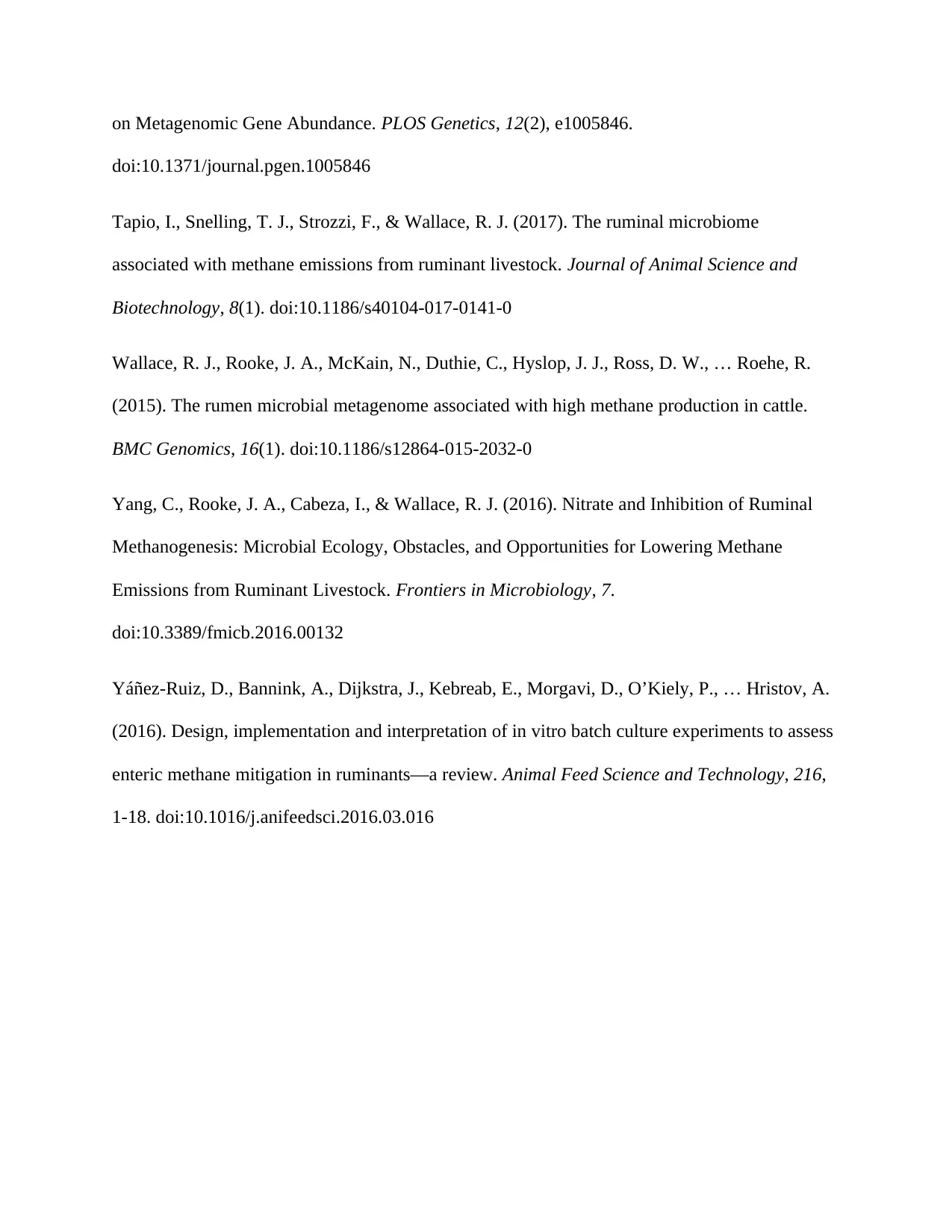
on Metagenomic Gene Abundance. PLOS Genetics, 12(2), e1005846.
doi:10.1371/journal.pgen.1005846
Tapio, I., Snelling, T. J., Strozzi, F., & Wallace, R. J. (2017). The ruminal microbiome
associated with methane emissions from ruminant livestock. Journal of Animal Science and
Biotechnology, 8(1). doi:10.1186/s40104-017-0141-0
Wallace, R. J., Rooke, J. A., McKain, N., Duthie, C., Hyslop, J. J., Ross, D. W., … Roehe, R.
(2015). The rumen microbial metagenome associated with high methane production in cattle.
BMC Genomics, 16(1). doi:10.1186/s12864-015-2032-0
Yang, C., Rooke, J. A., Cabeza, I., & Wallace, R. J. (2016). Nitrate and Inhibition of Ruminal
Methanogenesis: Microbial Ecology, Obstacles, and Opportunities for Lowering Methane
Emissions from Ruminant Livestock. Frontiers in Microbiology, 7.
doi:10.3389/fmicb.2016.00132
Yáñez-Ruiz, D., Bannink, A., Dijkstra, J., Kebreab, E., Morgavi, D., O’Kiely, P., … Hristov, A.
(2016). Design, implementation and interpretation of in vitro batch culture experiments to assess
enteric methane mitigation in ruminants—a review. Animal Feed Science and Technology, 216,
1-18. doi:10.1016/j.anifeedsci.2016.03.016
doi:10.1371/journal.pgen.1005846
Tapio, I., Snelling, T. J., Strozzi, F., & Wallace, R. J. (2017). The ruminal microbiome
associated with methane emissions from ruminant livestock. Journal of Animal Science and
Biotechnology, 8(1). doi:10.1186/s40104-017-0141-0
Wallace, R. J., Rooke, J. A., McKain, N., Duthie, C., Hyslop, J. J., Ross, D. W., … Roehe, R.
(2015). The rumen microbial metagenome associated with high methane production in cattle.
BMC Genomics, 16(1). doi:10.1186/s12864-015-2032-0
Yang, C., Rooke, J. A., Cabeza, I., & Wallace, R. J. (2016). Nitrate and Inhibition of Ruminal
Methanogenesis: Microbial Ecology, Obstacles, and Opportunities for Lowering Methane
Emissions from Ruminant Livestock. Frontiers in Microbiology, 7.
doi:10.3389/fmicb.2016.00132
Yáñez-Ruiz, D., Bannink, A., Dijkstra, J., Kebreab, E., Morgavi, D., O’Kiely, P., … Hristov, A.
(2016). Design, implementation and interpretation of in vitro batch culture experiments to assess
enteric methane mitigation in ruminants—a review. Animal Feed Science and Technology, 216,
1-18. doi:10.1016/j.anifeedsci.2016.03.016
⊘ This is a preview!⊘
Do you want full access?
Subscribe today to unlock all pages.

Trusted by 1+ million students worldwide
1 out of 9
Your All-in-One AI-Powered Toolkit for Academic Success.
+13062052269
info@desklib.com
Available 24*7 on WhatsApp / Email
![[object Object]](/_next/static/media/star-bottom.7253800d.svg)
Unlock your academic potential
Copyright © 2020–2025 A2Z Services. All Rights Reserved. Developed and managed by ZUCOL.